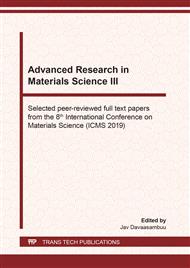[1]
A.R. Radnaev, S.V. Kalashnikov, A.V. Nomoev, E.L. Dzidziguri, Technological and strength properties of silumin modified with silicon dioxide nanoparticles, Metals 1 (2017) 37-42.
DOI: 10.1134/s0036029517010098
Google Scholar
[2]
V.V. Statsura, L.A. Oborin, A.I. Cherepanov et al., Ultrafine powders in foundry, Ultrafine powders, nanostructures, materials: Materials of the Russian scientific and technical conference (in Russian), Krasnoyarsk: Siberian Federal University (2003) 263.
Google Scholar
[3]
B.G. Zhalsanov, Improvement and optimization of technological processes for the production of non-ferrous metals: final qualification work (master's level): 04/22/02 (in Russian) Irkutsk National Research Technical University, Irkutsk (2018) 64.
Google Scholar
[4]
V.V. Statsura, V.V. Leonov, L.I. Mamina et al., Prospects for the creation of foundry composite materials of the type Al-A12O3-SiO2, Liteinoye Proizvodstvo (Foundry. Technologies and Equipment) (in Russian) 2 (2003) 11-12.
Google Scholar
[5]
Yu. A. Kurganova, Development and application of dispersion-hardened aluminomatric composite materials in mechanical engineering, Doct. Diss. Moscow (2008).
Google Scholar
[6]
O.V. Anisimov, Technology for producing composite materials based on aluminum, hardened by dispersed ZrO2 and SiC nanoparticles in the field of centrifugal centrifuge forces. Cand. Diss. Moscow (2012).
Google Scholar
[7]
A.N. Bazulev, N.Yu. Sdobnyakov, Calculation of the surface tension of nanometer microparticles based on the thermodynamic perturbation theory, Bulletin of Tver State University. Series: Physics 4 (6) (2014) 140-143.
Google Scholar
[8]
S.Sh. Rekhviashvili, E.V. Kishtikova, Influence of the dimensional dependence of surface tension on the dynamics of a bubble in a liquid, J. of Technical Physics 81(1) (2011) 148-152.
Google Scholar
[9]
V.V. Syzrantsev, V.M. Samsonov et al, Bonded layer and viscosity of nanofluids, Doklady Akademii Nauk 460 (3) (2015) 290-292.
Google Scholar
[10]
N.Yu. Sdobnyakov, Evaluation of the criterion of thermodynamic stability of metal nanoparticles using confidence intervals for the proportionality coefficient in the Rusanov formula for surface tension, Bulletin of Novgorod State University. Yaroslav the wise 5 (103) (2017) 43-48.
Google Scholar
[11]
S.V. Kalashnikov, A.V. Nomoev, E.L. Dzidziguri et al., Differentiation of silicon dioxide nanoparticles by size in the field of centrifugal forces, Russian Nanotechnologies 9 (9-10) (2014) 52-54.
DOI: 10.1134/s199507801405005x
Google Scholar
[12]
N. Sobczak, Jerzy J. Sobczak, R. Asthana, R. Purgert, The mystery of molten metal, November (2010) China foundry 7 (4): 425-437.
Google Scholar
[13]
A.V. Arabey, I.V. Rafalsky, Synthesis of aluminum-silicon alloys by direct reduction of silicon using aluminomatrix composite ligatures, Casting and metallurgy 3 (61) (2011) 19-25.
Google Scholar
[14]
A.V. Nomoev, S.P. Bardakhanov, M. Schreiber et al, Structure and mechanism of the formation of core-shell nanoparticles obtained through a one-step gas-phase synthesis by electron beam evaporation, Beilstein Journal of Nanotechnology 6 (1) (2015) 874-880.
DOI: 10.3762/bjnano.6.89
Google Scholar
[15]
A.V. Nomoev, A.R. Radnaev, S.V. Kalashnikov, Nature of diffraction fringes originating in the core of core-shell nanoparticle Cu/SiO2 and formation mechanism of the structures, Chemical Physics Letters 651 (2016) 274-277.
DOI: 10.1016/j.cplett.2016.02.019
Google Scholar


